| Didecyl dimethyl ammonium chloride | 9.2% |
| Alkyl (C12-67%, C14-25%, C16-7%, C18-1%) dimethyl benzyl ammonium chloride | 7.6% |
| Alkyl (C12-40%, C14-50%, C16-10%) dimethyl benzyl ammonium chloride | 6.2% |
-
 BioSentry 904 Disinfectant is effective in 400 ppm hard water (as CaCO3). Disinfects in 5% organic soil load. Recommended for chicken, turkey, duck, quail, goose, ostrich and other avian hatcheries. Effective in poultry, swine and livestock (including equine) premises. Useful in laboratory animal and animal breeder facilities. BioSentry 904 Disinfectant contains sequestering agents, to prevent the precipitation of minerals and metals from hard water. ● deodorizes by killing most microorganisms that cause offensive odours. ● contains no perfume to mask or hide any odours that might exist. DIN 02319756 Active Ingredients
BioSentry 904 Disinfectant is effective in 400 ppm hard water (as CaCO3). Disinfects in 5% organic soil load. Recommended for chicken, turkey, duck, quail, goose, ostrich and other avian hatcheries. Effective in poultry, swine and livestock (including equine) premises. Useful in laboratory animal and animal breeder facilities. BioSentry 904 Disinfectant contains sequestering agents, to prevent the precipitation of minerals and metals from hard water. ● deodorizes by killing most microorganisms that cause offensive odours. ● contains no perfume to mask or hide any odours that might exist. DIN 02319756 Active Ingredients -
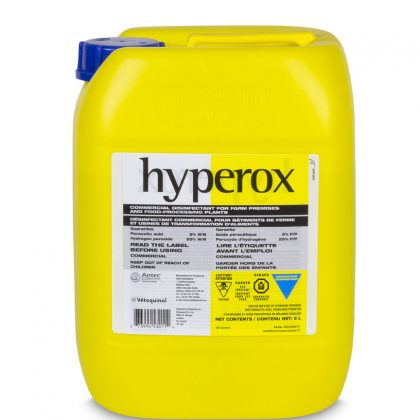 Hyperox consists of a blend of peracetic acid, hydrogen peroxide, acetic acid and surfactant in a long lasting stabilized aqueous solution. Hyperox has a broad spectrum biocidal activity and is non-tainting, does not leave residues after application and degrades to acetic acid, oxygen and water, each of which presents low environmental hazards. DIN 02240361 Active IngredientsPeracetic acid: 5% W/W Hydrogen peroxide: 25% W/W.
Hyperox consists of a blend of peracetic acid, hydrogen peroxide, acetic acid and surfactant in a long lasting stabilized aqueous solution. Hyperox has a broad spectrum biocidal activity and is non-tainting, does not leave residues after application and degrades to acetic acid, oxygen and water, each of which presents low environmental hazards. DIN 02240361 Active IngredientsPeracetic acid: 5% W/W Hydrogen peroxide: 25% W/W.Directions For Use
For best results, pre-clean all surfaces using a detergent before using Hyperox™. For routine disinfection of hard non-porous surfaces like floors, walls, concrete, plastic, stainless steel, glass, enameled surfaces, tile and any other hard non-porous surfaces which are not harmed by water: A 1:256 solution of Hyperox™ (1 part of Hyperox™ in 255 parts of water) is recommended for terminal disinfection. In farm premises: Remove all poultry, livestock and feeds from premises during disinfection. Remove all manure, litter and droppings from floors, walls, and surfaces of facilities occupied or traversed by poultry or livestock. Empty all troughs, racks, and other feeding and watering appliances. Using a pressure washer or mechanical sprayer, saturate surfaces with the solution at a rate of 300 mL per square meter (10 minute minimum contact time) and allow surfaces to dry before restocking. Ventilate building, coops and other closed spaces. All treated feed racks, mangers, troughs, automatic feeders, fountains, and waterers must be thoroughly rinsed with potable water prior to reuse. In food-processing plants: For food contact surfaces, rinse thoroughly with potable water after treatment with Hyperox™. For disinfection of equipment: A 1:128 solution of Hyperox™ (1 part of Hyperox™ in 127 parts of water) is recommended for cleaning and disinfecting equipment (such as buckets and utensils). Remove heavy soil from equipment to be treated. Allow disinfectant solution to remain in contact with the equipment for at least 10 minutes. Any milking equipment or equipment in contact with food where the product has been used should be flushed with potable water prior to reuse. For disinfection of foot and wheel dips: Foot and wheel dips disinfection can be made using a 1:128 solution of Hyperox™ (1 part of Hyperox™ in 127 parts of water). Boots and wheels should be immersed for at least one minute, so as to completely wet surfaces and allowed to air dry. Change foot or wheel dips’ solution when soiled or daily. For disinfection of water systems: A 1:256 solution of Hyperox™ (1 part of Hyperox™ in 255 parts of water) is recommended for water systems disinfection. Drain the system and fill with the solution for a 10 minute contact time. Drain and flush the water lines with potable water after disinfection. For disinfection by fogging: A 1:10 solution of Hyperox™ (1 part of Hyperox™ in 9 parts of water) is recommended for fogging. Use a thermal or mechanical fogging machine and apply at the rate of 17 mL per cubic meter. Leave for 30 minutes and vent for 30 minutes to 1 hour before re-entry.Storage
Store in the original container in a cool, well-ventilated dry room. Keep product away from sources of heat and combustible material. Avoid direct sunlight. Store away from food, feed or other pesticides. Containers must be stored upright only (do not block cap vent).Disposal
Do not reuse container. Follow provincial instructions for any additional cleaning of the container prior to its disposal. Make the empty container unsuitable for further use. Dispose of the container in accordance with provincial requirements. For information on the disposal of unused, unwanted product and the cleanup of spills, contact the provincial regulatory agency or the manufacturer.Precautions
KEEP OUT OF REACH OF CHILDREN: Oxidizing agent, corrosive to the eyes and skin. Do not inhale vapours given off by the product. Harmful or fatal if swallowed. Do not get in eyes, on skin, or on clothing. Wash hands, face and exposed skin before eating, drinking, or smoking, and after leaving the work area. Remove contaminated clothing and wash clothing before reuse. Avoid all contact by mouth, with skin or eyes. Accidental splashes on exposed skin or eyes should be washed off immediately with plenty of water. Wear suitable protective clothing (e.g. aprons, coveralls, complete footwear, etc.), chemical resistant gloves (e.g. nitrile or butyle rubber) and face protection (e.g. face shield, goggles, mask, etc.) when handling the concentrate and during application of product. When applying product by spraying or fogging, wear chemical resistant respirator. Do not remain in treated areas. Ensure proper ventilation after sealed areas have been treated. Do not contaminate food, feed or water troughs. Any treated surface or utensils that may contact food or feed products should be washed thoroughly with potable water after disinfection and before reuse. Do not return unused concentrate to the container in order to avoid possibility of contamination. TOXICOLOGICAL INFORMATION: Hyperox™ is an oxidizing agent and is corrosive and irritant. It can cause severe burns. Treat symptomatically. FIRST AID: Eye contact: If the product or its dilutions are splashed into the eye, rinse immediately with plenty of water or buffered eyewash. Remove any contact lenses. Seek medical advice immediately. Skin contact: Rinse any product off the skin immediately with water. Remove contaminated clothing and wash with water. Seek medical advice immediately. Ingestion: Allow patient to drink water if conscious, but do not induce vomiting. Rinse mouth out with water. Seek medical advice immediately. Inhalation: Remove affected person to fresh air. Keep upper body raised. Keep warm and in a stable position. Seek medical advice immediately. MSDS -
 Proxy-Clean is a stabilized hydrogen peroxide based product specially formulated to remove and prevent heavy soils in livestock operations of any size. Proxy-Clean utilizes a proprietary stabilizer that is an active ingredient not found in any other product. The stabilizers used in other hydrogen peroxide products just allow them to be shelf stable. Proxy-Clean’s proprietary stabilizer acts as a decomposition catalyst allowing Proxy-Clean to do a complete cleaning on water lines and watering systems. Active IngredientsStabilized Hydrogen peroxide: 50% W/W.
Proxy-Clean is a stabilized hydrogen peroxide based product specially formulated to remove and prevent heavy soils in livestock operations of any size. Proxy-Clean utilizes a proprietary stabilizer that is an active ingredient not found in any other product. The stabilizers used in other hydrogen peroxide products just allow them to be shelf stable. Proxy-Clean’s proprietary stabilizer acts as a decomposition catalyst allowing Proxy-Clean to do a complete cleaning on water lines and watering systems. Active IngredientsStabilized Hydrogen peroxide: 50% W/W.Directions For Use
With Animals Present Mix Proxy-Clean with water to create the following stock solutions:
Discontinue use of any medication, chlorine or sanitizer when administering Proxy Clean. Resume the use of chlorine or other sanitizers after Proxy Clean treatment is finished. For routine sanitation use Proxy Clean at 25-50ppm in the drinking water (use test strips to measure concentration). Between 2 Lots/No Animals Present Fill the water lines with a Proxy Clean/water solution using the following options: Option 1: Use a 1:100 or 1:128 medicator to fill the water lines with a 1% or 0.78% solution of Proxy Clean. Allow the solution to remain in the water lines for a minimum of 48 hours before flushing. Option 2: Use a 3:100 medicator to fill the water lines with a 3% solution of Proxy Clean. Allow the solution to remain in the water lines for a minimum of 12 hours before flushing. When using Proxy Clean make sure that there is an adequate air release from your water system.Pump Water Proxy Clean Days 1 & 2 3 & 4 5 & 6 7-10 1:100 20L 250mL 350mL 475mL 600mL 1:128 20L 320mL 450mL 600mL 775mL Storage & Disposal
Please refer to MSDS sheet.Precautions & First Aid
Please refer to MSDS sheet. MSDS -
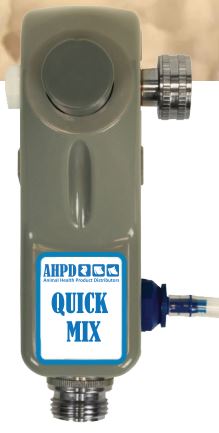 The Quick-Mix pump is designed to accurately dose disinfectants through your water lines. The unique injection system makes it easy to dose disinfectants at 2 or 3% without having to worry about harsh chemicals wrecking diaphragms. To change the dilution ratio simply change the metering tip to the desired strength. Comes with tips for Proxy-Clean, Hyperox, Virocid and many other disinfectants. The quick-Mix is a wall mounted, push button dispenser.
The Quick-Mix pump is designed to accurately dose disinfectants through your water lines. The unique injection system makes it easy to dose disinfectants at 2 or 3% without having to worry about harsh chemicals wrecking diaphragms. To change the dilution ratio simply change the metering tip to the desired strength. Comes with tips for Proxy-Clean, Hyperox, Virocid and many other disinfectants. The quick-Mix is a wall mounted, push button dispenser.- Ideal for cleaning waterlines between flocks
- Garden hose connection
- Twist Lock
- Compatible with most common chemicals
- No power needed
- No Diaphragms
- Affordable, low maintenance unit
- Flow Rate - requires at least (3.5GPM)
- Compatible with chlorine, Hydrogen peroxide & more.
-
 Stalosan F is designed to uniquely meet the hygiene needs of the modern poultry industry. It kills a wide range of pathogens, including bacteria, viruses, fungi, parasites, and flies. Stalosan F also plays an important role in your birds’ environment as a litter conditioner. It is effective in improving air quality and neutralizing harmful substances such as ammonia and hydrogen sulfide. MSDS
Stalosan F is designed to uniquely meet the hygiene needs of the modern poultry industry. It kills a wide range of pathogens, including bacteria, viruses, fungi, parasites, and flies. Stalosan F also plays an important role in your birds’ environment as a litter conditioner. It is effective in improving air quality and neutralizing harmful substances such as ammonia and hydrogen sulfide. MSDS -
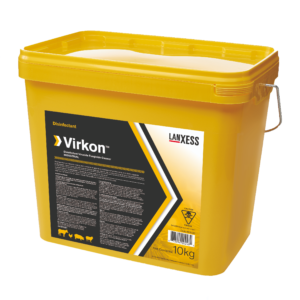 Virkon™ is a disinfectant, possessing wide spectrum virucidal, bactericidal and fungicidal activity. The effectiveness of Virkon™ is further enhanced by its excellent detergent properties, so that clean disease-free surfaces can be achieved. Virkon™ is unique in its composition. Its activity is based on a buffered synergized acid peroxygen system containing a high percentage of surfactant. Virkon™ can be used on all surfaces and in all situations. Once diluted in a 1% solution, Virkon™ is of low toxicity, non-tainting, and non-irritant. Because of its high detergency and mode of action, Virkon™ can be used in an exceptional variety of situations for effective cleaning and virucidal disinfection in a single operation. Virkon™ can be applied manually or through all types of cleaning and spraying equipment. Readily soluble in lukewarm water giving a clear pink solution. Virkon™ consists mainly of inorganic salts. DIN 02125021 Active Ingredients
Virkon™ is a disinfectant, possessing wide spectrum virucidal, bactericidal and fungicidal activity. The effectiveness of Virkon™ is further enhanced by its excellent detergent properties, so that clean disease-free surfaces can be achieved. Virkon™ is unique in its composition. Its activity is based on a buffered synergized acid peroxygen system containing a high percentage of surfactant. Virkon™ can be used on all surfaces and in all situations. Once diluted in a 1% solution, Virkon™ is of low toxicity, non-tainting, and non-irritant. Because of its high detergency and mode of action, Virkon™ can be used in an exceptional variety of situations for effective cleaning and virucidal disinfection in a single operation. Virkon™ can be applied manually or through all types of cleaning and spraying equipment. Readily soluble in lukewarm water giving a clear pink solution. Virkon™ consists mainly of inorganic salts. DIN 02125021 Active IngredientsPotassium monopersulfate 21.4% W/W Directions For Use
In agricultural buildings: animals must be removed from the premise during disinfection. In food processing plants: for food contact surfaces, rinse thoroughly with potable water after disinfection. 1. FOR CLEANING AND DISINFECTION OF SURFACES AND EQUIPMENT: In agricultural buildings Remove all animals from premises. Remove all litter and manure from floors, walls, and other surfaces of barns and equipment. Brush and blow dust from fans, motors, louvers and electrical equipment. For terminal cleaning and disinfection, saturate all surfaces with a 1% w/v solution of Virkon™, using a pressure washer or a fogger. Virkon™ should remain in contact with the surface to be disinfected for at least 10 minutes. Scrub heavily soiled utensils and soak in a 1% w/v solution of Virkon™ for 10 minutes (do not exceed 30 minutes for metal objects). In veterinary hospitals Remove heavy soil deposits then thoroughly wet surfaces to be disinfected with a 1% w/v solution of Virkon™, using a mop, sponge or cloth, as well as by spraying. A minimum contact time of 10 minutes is required. For laboratory equipment and bowls, scrub heavily soiled utensils and soak in a 1% w/v solution of Virkon™ for a minimum of 10 minutes (do not exceed 30 minutes for metal objects). IMPORTANT NOTE: In animal premises where there has been a disease outbreak and/or the mortality/morbidity rates are higher than normal and the causative agent has been determined by a pathology laboratory to be one of those listed in Table 1, the contact time/dilution rate indicated should be used. In food processing plants Remove all debris and other deposits from surfaces. Then, thoroughly wet surfaces to be disinfected with a 1% w/v solution of Virkon™, using a mop, sponge or cloth, as well as by spraying. A minimum contact time of 10 minutes is required. For food contact surfaces, rinse thoroughly with potable water after treatment with Virkon™. For a complete listing of microorganisms against which Virkon™ is effective, refer to the Efficacy Charts 2, 3, and 4. 2. FOR AERIAL DISINFECTION: To replace dangerous and ineffective formalin fumigation in empty farm buildings and veterinary hospitals. Shutdown the ventilation system during the disinfection. Use a mechanical fogging machine as part of terminal disinfection routine with a 1% w/v solution of Virkon™. Apply at a rate of one litre of solution per 100 m3 with particle size not exceeding 70 microns in order to get a minimal contact time of 10 minutes with microorganisms in the air. Leave the room during the fogging. Users and animals may re-enter the treated area once the fog has dispersed. No rinsing is required after fogging. 3. SANITIZING DRINKING WATER SYSTEM: For sanitizing drinking water system at terminal clean out, use a 1.0% w/v solution of Virkon™. Dose header tank and drain system. Wait at least 10 minutes before draining again. DILUTION INSTRUCTIONS1) Select the quantity of disinfectant solution required. 2) Choose appropriate dilution rate. 3) Measure out the amount of Virkon™ indicated using the graduated measuring scoop provided. 4) Add Virkon™ to warm water and stir. There is a 20% loss of activity of 1% solutions of Virkon™ after 14 days in 350 ppm hard water.Dilution rate required (w/v) Quantity of disinfectant solution required 3.0% 2.0% 1.0% 0.5% 0.2% Quantity of Virkon™ required 30 g 20 g 10 g 5 g 2 g 1 Litre 150 g 100 g 50 g 25 g 10 g 5 Litres 300 g 200 g 100 g 50 g 20 g 10 Litres 750 g 500 g 250 g 125 g 50 g 25 Litres Storage
Store between 15°C and 25°C in a dry place in tightly sealed containers.Disposal
1) Rinse the emptied container thoroughly and add the rinsings to treatment site. 2) Follow provincial instructions for any required additional cleaning of the container prior to its disposal. 3) Make the empty container unsuitable for further use. 4) Dispose of the container in accordance with provincial requirements. 5) For information on the disposal of unused, unwanted product and the cleanup of spills, contact the Provincial Regulatory Agency or the Manufacturer.Precautions
Keep out of reach of children. Powder irritating to eyes, skin and mucous membranes. May be harmful if swallowed or inhaled. Do not get powder in eyes. Avoid contact of powder with skin. Handle in such a way as to minimize dust release. Do not mix with other chemicals. When mixing the solution, wear goggles, chemical-resistant gloves, and a mask. It is recommended that workers wear overalls, goggles and a mask when applying Virkon™ solution with a hand-held fogger or a pressure washer.First Aid
Eyes: Irrigate with plenty of water. Skin: When in powder, remove contaminated clothing. Wash with soap and water. Not hazardous when in solution. Ingestion: When in powder, wash mouth with plenty of water. Drink plenty of water. Do not induce vomiting. Seek medical advice. If in solution, rinse mouth out with water. Inhalation: When in powder, if symptoms of coughing, choking, wheezing are troublesome, remove to fresh air and seek medical advice. MSDS -
 Virkon™ is a disinfectant, possessing wide spectrum virucidal, bactericidal and fungicidal activity. The effectiveness of Virkon™ is further enhanced by its excellent detergent properties, so that clean disease-free surfaces can be achieved. Virkon™ is unique in its composition. Its activity is based on a buffered synergized acid peroxygen system containing a high percentage of surfactant. Virkon™ can be used on all surfaces and in all situations. Once diluted in a 1% solution, Virkon™ is of low toxicity, non-tainting, and non-irritant. Because of its high detergency and mode of action, Virkon™ can be used in an exceptional variety of situations for effective cleaning and virucidal disinfection in a single operation. Virkon™ can be applied manually or through all types of cleaning and spraying equipment. Readily soluble in lukewarm water giving a clear pink solution. Virkon™ consists mainly of inorganic salts. DIN 02125021 Active Ingredients
Virkon™ is a disinfectant, possessing wide spectrum virucidal, bactericidal and fungicidal activity. The effectiveness of Virkon™ is further enhanced by its excellent detergent properties, so that clean disease-free surfaces can be achieved. Virkon™ is unique in its composition. Its activity is based on a buffered synergized acid peroxygen system containing a high percentage of surfactant. Virkon™ can be used on all surfaces and in all situations. Once diluted in a 1% solution, Virkon™ is of low toxicity, non-tainting, and non-irritant. Because of its high detergency and mode of action, Virkon™ can be used in an exceptional variety of situations for effective cleaning and virucidal disinfection in a single operation. Virkon™ can be applied manually or through all types of cleaning and spraying equipment. Readily soluble in lukewarm water giving a clear pink solution. Virkon™ consists mainly of inorganic salts. DIN 02125021 Active IngredientsPotassium monopersulfate 21.4% W/W Directions For Use
In agricultural buildings: animals must be removed from the premise during disinfection. In food processing plants: for food contact surfaces, rinse thoroughly with potable water after disinfection. 1. FOR CLEANING AND DISINFECTION OF SURFACES AND EQUIPMENT: In agricultural buildings Remove all animals from premises. Remove all litter and manure from floors, walls, and other surfaces of barns and equipment. Brush and blow dust from fans, motors, louvers and electrical equipment. For terminal cleaning and disinfection, saturate all surfaces with a 1% w/v solution of Virkon™, using a pressure washer or a fogger. Virkon™ should remain in contact with the surface to be disinfected for at least 10 minutes. Scrub heavily soiled utensils and soak in a 1% w/v solution of Virkon™ for 10 minutes (do not exceed 30 minutes for metal objects). In veterinary hospitals Remove heavy soil deposits then thoroughly wet surfaces to be disinfected with a 1% w/v solution of Virkon™, using a mop, sponge or cloth, as well as by spraying. A minimum contact time of 10 minutes is required. For laboratory equipment and bowls, scrub heavily soiled utensils and soak in a 1% w/v solution of Virkon™ for a minimum of 10 minutes (do not exceed 30 minutes for metal objects). IMPORTANT NOTE: In animal premises where there has been a disease outbreak and/or the mortality/morbidity rates are higher than normal and the causative agent has been determined by a pathology laboratory to be one of those listed in Table 1, the contact time/dilution rate indicated should be used. In food processing plants Remove all debris and other deposits from surfaces. Then, thoroughly wet surfaces to be disinfected with a 1% w/v solution of Virkon™, using a mop, sponge or cloth, as well as by spraying. A minimum contact time of 10 minutes is required. For food contact surfaces, rinse thoroughly with potable water after treatment with Virkon™. For a complete listing of microorganisms against which Virkon™ is effective, refer to the Efficacy Charts 2, 3, and 4. 2. FOR AERIAL DISINFECTION: To replace dangerous and ineffective formalin fumigation in empty farm buildings and veterinary hospitals. Shutdown the ventilation system during the disinfection. Use a mechanical fogging machine as part of terminal disinfection routine with a 1% w/v solution of Virkon™. Apply at a rate of one litre of solution per 100 m3 with particle size not exceeding 70 microns in order to get a minimal contact time of 10 minutes with microorganisms in the air. Leave the room during the fogging. Users and animals may re-enter the treated area once the fog has dispersed. No rinsing is required after fogging. 3. SANITIZING DRINKING WATER SYSTEM: For sanitizing drinking water system at terminal clean out, use a 1.0% w/v solution of Virkon™. Dose header tank and drain system. Wait at least 10 minutes before draining again. DILUTION INSTRUCTIONS1) Select the quantity of disinfectant solution required. 2) Choose appropriate dilution rate. 3) Measure out the amount of Virkon™ indicated using the graduated measuring scoop provided. 4) Add Virkon™ to warm water and stir. There is a 20% loss of activity of 1% solutions of Virkon™ after 14 days in 350 ppm hard water.Dilution rate required (w/v) Quantity of disinfectant solution required 3.0% 2.0% 1.0% 0.5% 0.2% Quantity of Virkon™ required 30 g 20 g 10 g 5 g 2 g 1 Litre 150 g 100 g 50 g 25 g 10 g 5 Litres 300 g 200 g 100 g 50 g 20 g 10 Litres 750 g 500 g 250 g 125 g 50 g 25 Litres Storage
Store between 15°C and 25°C in a dry place in tightly sealed containers.Disposal
1) Rinse the emptied container thoroughly and add the rinsings to treatment site. 2) Follow provincial instructions for any required additional cleaning of the container prior to its disposal. 3) Make the empty container unsuitable for further use. 4) Dispose of the container in accordance with provincial requirements. 5) For information on the disposal of unused, unwanted product and the cleanup of spills, contact the Provincial Regulatory Agency or the Manufacturer.Precautions
Keep out of reach of children. Powder irritating to eyes, skin and mucous membranes. May be harmful if swallowed or inhaled. Do not get powder in eyes. Avoid contact of powder with skin. Handle in such a way as to minimize dust release. Do not mix with other chemicals. When mixing the solution, wear goggles, chemical-resistant gloves, and a mask. It is recommended that workers wear overalls, goggles and a mask when applying Virkon™ solution with a hand-held fogger or a pressure washer.First Aid
Eyes: Irrigate with plenty of water. Skin: When in powder, remove contaminated clothing. Wash with soap and water. Not hazardous when in solution. Ingestion: When in powder, wash mouth with plenty of water. Drink plenty of water. Do not induce vomiting. Seek medical advice. If in solution, rinse mouth out with water. Inhalation: When in powder, if symptoms of coughing, choking, wheezing are troublesome, remove to fresh air and seek medical advice. MSDS -
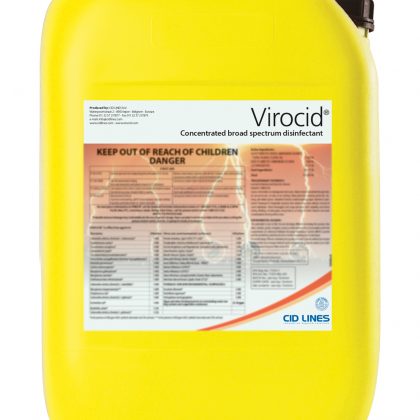 Virocid is a highly concentrated and broad spectrum disinfectant for use in food processing establishments, slaughter houses and livestock industries. Virocid is effective against: viruses, bacteria and fungi. Effective at rates as low as 0.25% (1:400). DIN 02239726 Active Ingredients
Virocid is a highly concentrated and broad spectrum disinfectant for use in food processing establishments, slaughter houses and livestock industries. Virocid is effective against: viruses, bacteria and fungi. Effective at rates as low as 0.25% (1:400). DIN 02239726 Active IngredientsAlkyl (40% C12, 50% C14, 10% C16) dimethyl benzyl ammonium chloride 17.06% Didecyl dimethyl ammonium chloride 7.80% Glutaraldehyde 10.725% Directions For Use
To disinfect hard non-porous surfaces (livestock equipment, floors, walls, table tops, counter tops), apply a 0.25% (1:400) solution to thoroughly wet surface. Spray the surface and let stand for 10 minutes. Virocid is a concentrate that can be used with a mop and bucket, trigger sprayers, sponge, or by soaking. Heavily soiled surfaces should be precleaned prior to disinfection. All food contact surfaces must be thoroughly rinsed with potable water after disinfection.Storage
Store in original container, in a dry, cool place. Do not store in food processing environments.Disposal
1. Rinse the emptied container thoroughly and add the rinsings to the treatment site. 2. Follow local instructions for any required additional cleaning of the container prior to disposal. 3. Make the empty container unsuitable for further use. 4. Disposal of product and packaging: The product and packaging must be disposed of in accordance with local requirements.Precautions
KEEP OUT OF REACH OF CHILDREN. Danger - Corrosive to eyes. Do not get in eyes, on skin or clothing. Use appropriate clothes, gloves and eye protection. Harmful if swallowed. Avoid contamination of food.First Aid
In case of contact, immediately flush eyes or skin with plenty of water for at least 15 minutes. For eyes, call a physician. Remove and wash contaminated clothing before reuse. If inhaled, breathe fresh air and consult a physician. If swallowed, do NOT induce vomiting. Call a physician or poison control centre immediately. MSDS -
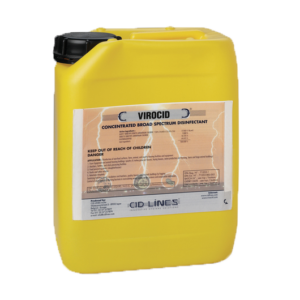 Virocid is a highly concentrated and broad spectrum disinfectant for use in food processing establishments, slaughter houses and livestock industries. Virocid is effective against: viruses, bacteria and fungi. Effective at rates as low as 0.25% (1:400). DIN 02239726 Active Ingredients
Virocid is a highly concentrated and broad spectrum disinfectant for use in food processing establishments, slaughter houses and livestock industries. Virocid is effective against: viruses, bacteria and fungi. Effective at rates as low as 0.25% (1:400). DIN 02239726 Active IngredientsAlkyl (40% C12, 50% C14, 10% C16) dimethyl benzyl ammonium chloride 17.06% Didecyl dimethyl ammonium chloride 7.80% Glutaraldehyde 10.725% Directions For Use
To disinfect hard non-porous surfaces (livestock equipment, floors, walls, table tops, counter tops), apply a 0.25% (1:400) solution to thoroughly wet surface. Spray the surface and let stand for 10 minutes. Virocid is a concentrate that can be used with a mop and bucket, trigger sprayers, sponge, or by soaking. Heavily soiled surfaces should be precleaned prior to disinfection. All food contact surfaces must be thoroughly rinsed with potable water after disinfection.Storage
Store in original container, in a dry, cool place. Do not store in food processing environments.Disposal
1. Rinse the emptied container thoroughly and add the rinsings to the treatment site. 2. Follow local instructions for any required additional cleaning of the container prior to disposal. 3. Make the empty container unsuitable for further use. 4. Disposal of product and packaging: The product and packaging must be disposed of in accordance with local requirements.Precautions
KEEP OUT OF REACH OF CHILDREN. Danger - Corrosive to eyes. Do not get in eyes, on skin or clothing. Use appropriate clothes, gloves and eye protection. Harmful if swallowed. Avoid contamination of food.First Aid
In case of contact, immediately flush eyes or skin with plenty of water for at least 15 minutes. For eyes, call a physician. Remove and wash contaminated clothing before reuse. If inhaled, breathe fresh air and consult a physician. If swallowed, do NOT induce vomiting. Call a physician or poison control centre immediately. MSDS
